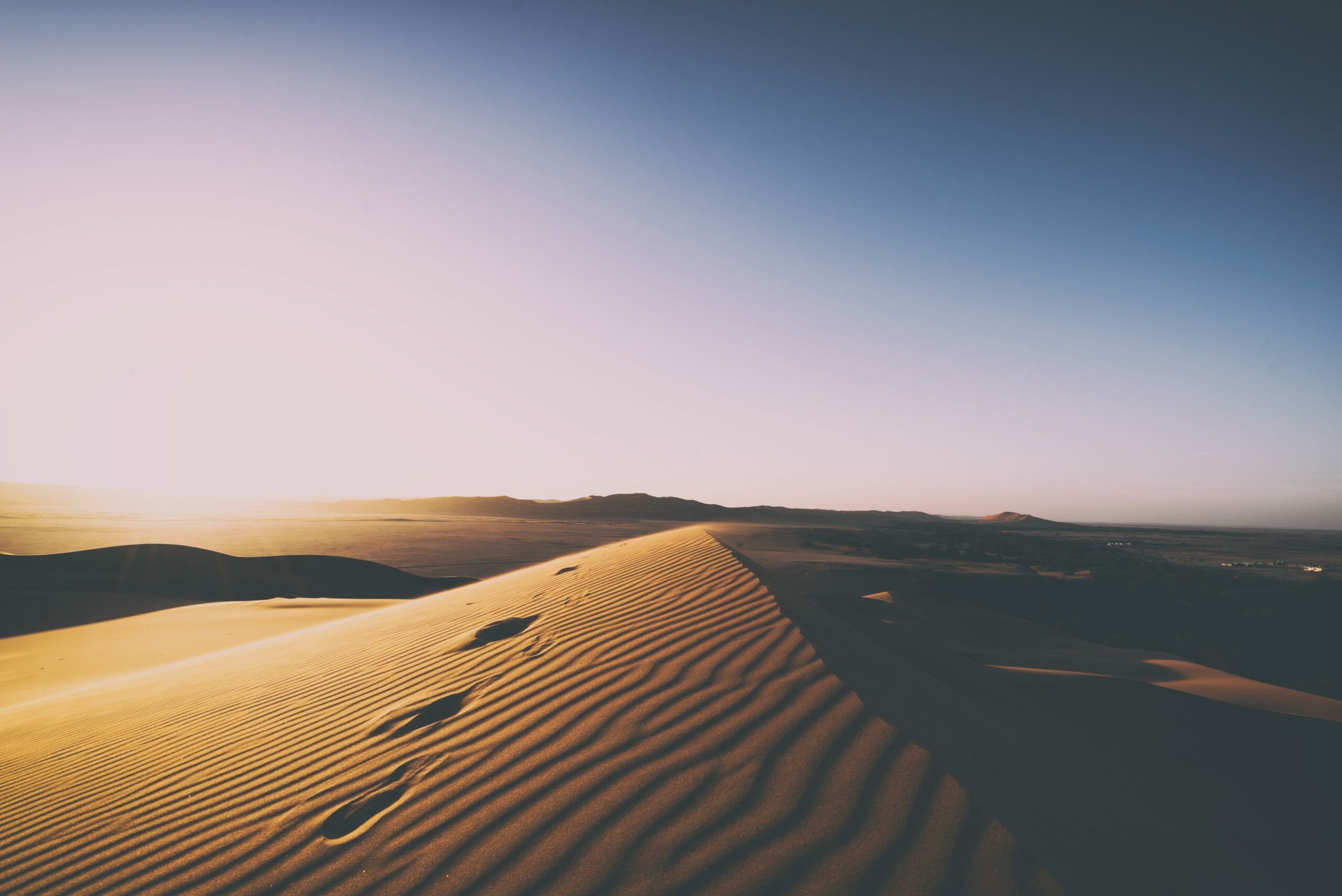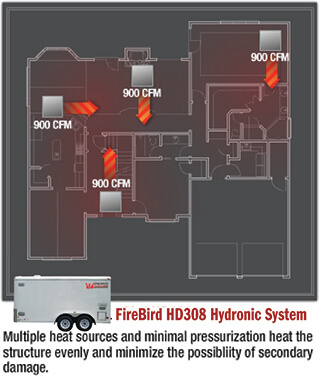
RESTORATION DRYING WITH HEAT
PART 1
This is a definitely a HOT topic. The subject can be emotional for proponents and opponents; the use and application of scientific principles is very seriously debated, even between heat advocates. Added to this, is the ominous potential of lawsuits and legal fees. Some restorers are afraid to even utter the word HEAT. This article should help restoration professionals to have a better understanding of heat, its consequences and its applications in restoration drying. This is a 2–part series intended give you enough background to understand how heat works and get past some common heat related mistakes and misconceptions. Part 1 concentrates on the science and properties of heat, water, and evaporation. The second part will focus more toward heat drying applications, along with some tips to use heat efficiently and profitably.
It is important to understand that everyone dries with heat. “Everyone dries with heat” because water requires a substantial amount of heat (energy) to change from a liquid to a vapor. It is equally important to understand that a “substantial amount of heat” is not the same as “high temperature”. The amount of heat in something is not the same thing as its temperature.

Heat can be measured, just like temperature. One way to measure heat uses BTUs (British thermal units). A BTU is about enough heat to raise the temperature of a pint of water 1°F; one BTU is not a lot of heat. If you had a gallon of water that you wanted to heat from cool to hot; from 50°F up to around 120°F, it would require adding about 560 BTUs (8 pints x 70°F change).
Evaporation requires considerably more heat (see Fig. 1). Evaporating a pint of water takes a little over 1,000 BTUs, and that is without even changing its temperature. The reason it takes all these BTUs to evaporate water is because the water molecules need to absorb enough heat energy to push way from each other — they need to convert from a liquid (close to each other) to a vapor (far apart). Evaporation does not require a temperature change; evaporation is a phase change. A pint of water will evaporate at 70°F and the water vapor will be at 70°F, all those 1,000 BTUs are used in the phase change needed to convert liquid water into water vapor. A pound of air at 70°F 25% RH contains about 21 BTUs. A pound of air at 70°F and 90% RH contains 32 BTUs. The same temperature but about 60% more heat content. These extra BTUs are referred to as latent heat because they do not show up in the temperature; they only make themselves known by a moisture content reading.
All vapors exert a pressure; called vapor pressure. In restoration, references to vapor pressure are assumed to be for water. Vapor pressure is a partial pressure. All the gases and vapors in air have their own partial pressures. These add-up to the atmospheric pressure. At any given temperature there is a maximum amount of water vapor that can exist within the air. This maximum is the saturation vapor pressure. Vapor pressure is often measured in inches of mercury (in. Hg) The weight of the water vapor in the air is measured in grains per pound (GPP).
When the temperature of the air is raised, the amount of moisture in the air (GPP) doesn’t change so the vapor pressure doesn’t change, but the maximum possible vapor pressure increases (more grains of water can exist in the warmer air). Liquid water does have a vapor pressure, and it is tied to temperature. If you raise the temperature of the water in the wet material, you raise the vapor pressure.
Vapor pressure differential drives evaporation. But temperature is one of the main controls over how fast it happens. The temperature at the surface of a wet material determines the saturation vapor pressure. The higher this temperature is, the higher the vapor pressure will be. The vapor pressure in the air can be determined by its temperature and RH (vapor pressure can be found on the psychrometric chart next to grains per pound). Assuming adequate airflow, the bigger the difference is between these two vapor pressures the faster the evaporation rate. Conversely, the smaller the difference is, the slower the evaporation rate. If the ambient air is already saturated, the material will not dry. When using heat to dry materials, the goal is to maximize the vapor pressure differential by adding heat to provide sufficient evaporation without excessive temperature rise rather than focusing on controlling the moisture content of the air through dehumidification.
How a heat control strategy compares to a moisture control strategy can be seen in the following example. Since the equilibrium moisture content (EMC) of wood and other hygroscopic materials is linked to the relative humidity of the air, it is a good guide to the eventual lowest attainable moisture content during drying. Air at 80°F and 23% RH has a humidity ratio of 35 gpp and will eventually dry wood to an EMC of 4.9%. Air at 100°F and 23% RH has a humidity ratio of 65 gpp and will eventually dry wood to an EMC of 4.7%, but the evaporation rate will be much faster because the warmer surfaces will produce higher vapor pressure. The 100°F job will require closer monitoring for some of the heat-related issues discussed in part 2. Understanding how to fine-tune the evaporation rate can help guide equipment selection as the drying job progresses.
“How much heat?” is a simple question but the answer can change from job to job… and from start to finish on the same job. These job to job changes will be discussed in part 2, but the main reason for the “start to finish” change is because when materials are wet the evaporating moisture protects them from overheating. As a job progresses and dries, heat can cause problems in some materials if temperature is not kept under control.
Warm air is usually used to transfer heat into the structure (and to the moisture) via convection, much like a convection oven. The heat source warms the air and then the air warms the structure and the liquid water. Some small area heating can be done using infrared (IR) “heat lamps”, but heat lamps are too inefficient for larger areas. Heat lamps use infrared radiation to apply the heat; this is line-of-sight transfer. The heat goes where it is aimed, without heating the air on the way. Convection (hot air) and radiation (IR) are the two main mechanisms used to apply heat in restorative drying.
There are several different ways to generate convective heat on a drying job. Direct fired heating units put the combustion gases in the heated air stream. Indirect fired heaters separate the combustion chamber from the heated air stream, similar to a forced air furnace. Hydronic heating equipment (see Pict. 1) heats a liquid (usually a food grade propylene glycol/water blend) then pumps the hot liquid, via hoses, to one or more fan coil units located inside the structure. And, of course, there are electrically powered heating units. Some heating systems emphasize focusing the heated air directly on wet materials while others warm the entire affected area.
The non-electric heat sources can be designed to use any of the commonly available fuels, such as natural gas, propane, or diesel fuel. Some of them allow field modifications to change the fuel type.
Part 2 will continue into the application area and offer some useful heating tips.
Larry Carlson; Restoration Industry Manager, Phoenix Restoration Equipment
Mike Steffes; Lab Scientist, Therma-Stor, LLC
